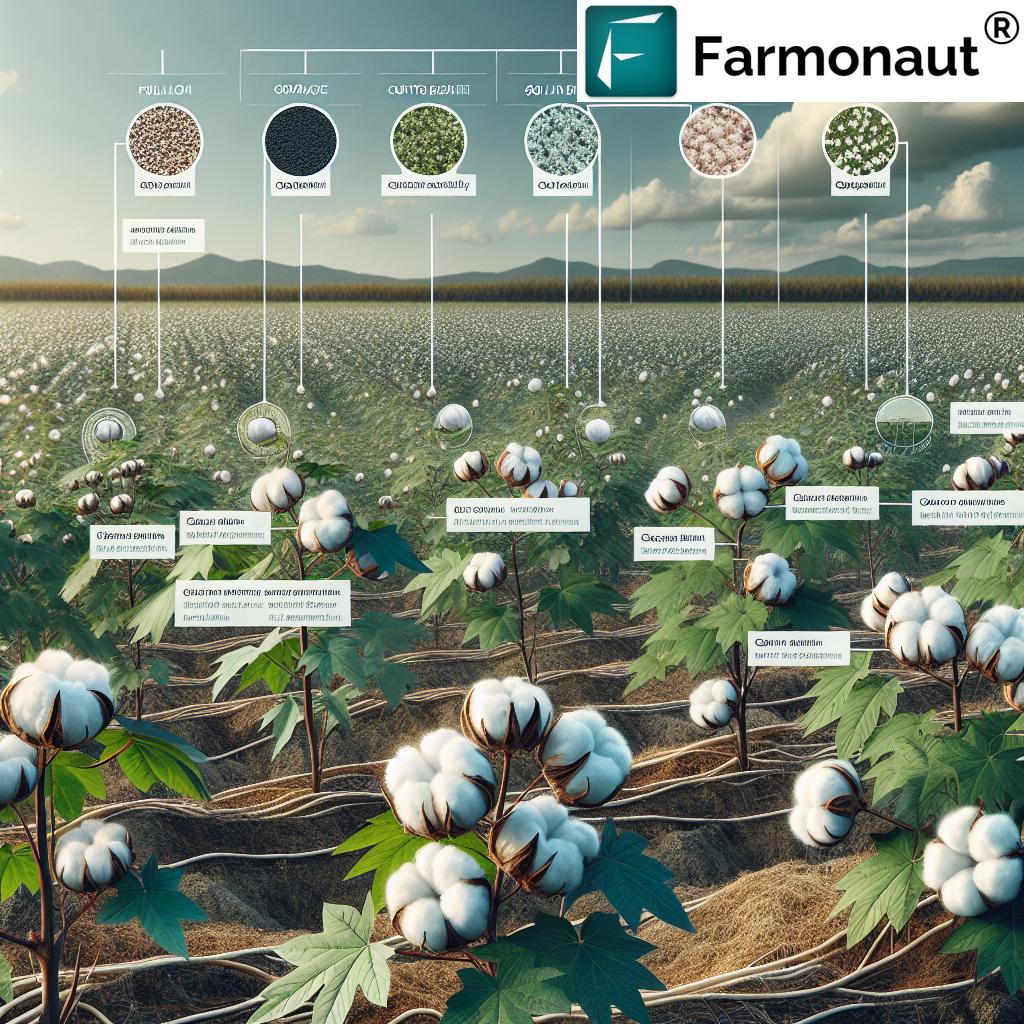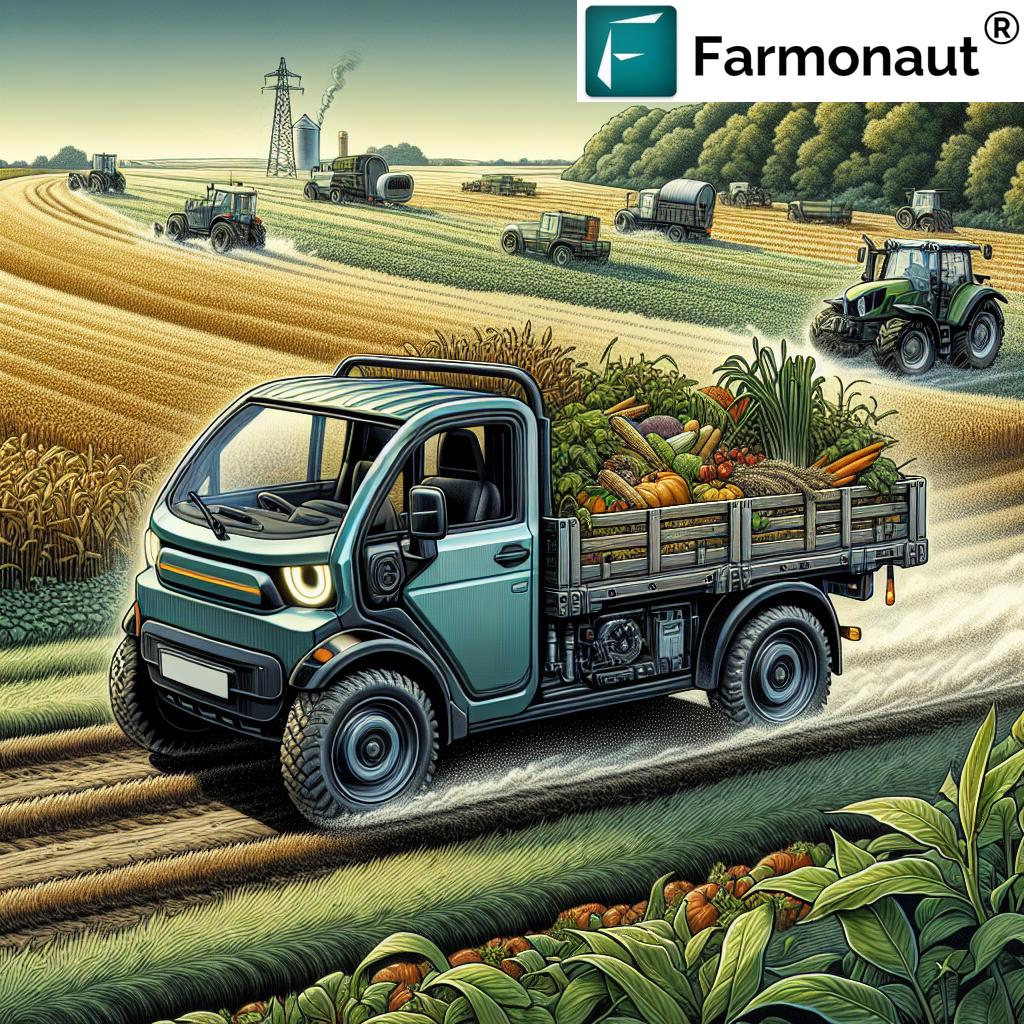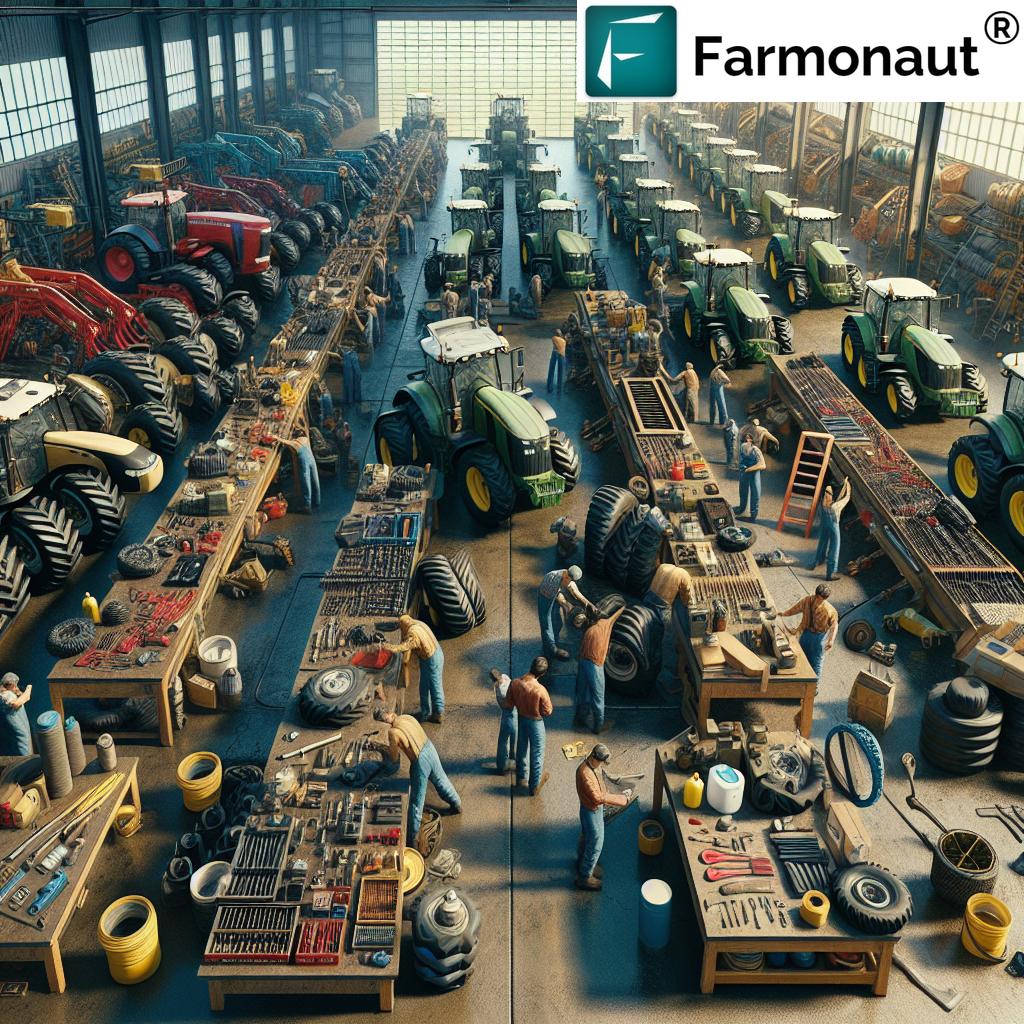Table of Contents
- Introduction: Revolutionizing Food Production in 2025
- What is Indoor Urban Agriculture?
- Trivia: Water Efficiency of Vertical Farms
- Technological Advances Driving Indoor Urban Farming
- Benefits of Indoor Urban Agriculture in 2025
- Indoor Urban Agriculture: 7 Game-Changing Trends for 2025
- Trends Comparison Table
- Trivia: Impact of LED Lighting in Urban Farms
- Farmonaut’s Role in the Evolution of Indoor Agriculture
- Frequently Asked Questions
- Conclusion: The Future is Urban, Indoor, and Sustainable
Indoor Urban Agriculture: 7 Game-Changing Trends for 2025
Meta Summary: Indoor urban agriculture is set to revolutionize food production in cities by 2025. Discover how innovative urban indoor farming systems are addressing sustainability, efficiency, and resilience in our growing urban centers.
“By 2025, vertical farms are projected to use up to 95% less water than traditional agriculture in urban settings.”
What is Indoor Urban Agriculture?
As the global population continues to swell and urbanization accelerates, urban indoor farming and indoor urban agriculture have emerged as transformative solutions for food production. These innovative systems involve cultivating crops within controlled environments situated in or near city areas, leveraging advanced technology to address the mounting challenges faced by traditional agriculture: dwindling arable land, climate change, supply chain disruptions, and limited resources.
Indoor urban agriculture covers various approaches, including:
- Vertical farms — Multi-level, space-optimized farms using techniques like hydroponics and aeroponics.
- Hydroponic and aquaponic systems — Soil-less environments where plants grow with regulated nutrients and water.
- Specialized indoor greenhouses — High-tech glasshouse facilities with AI, automation, and advanced energy management.
Unlike conventional outdoor farming, indoor urban farming offers independence from weather and unpredictable seasons. By controlling temperature, humidity, lighting, and nutrients, these systems deliver:
- Consistent, year-round production
- Higher yields per square foot
- Significantly reduced resource consumption and minimized environmental impact
In 2025, these innovative urban indoor farming models are not just experiments—they are scalable solutions, reshaping city landscapes and redefining sustainable food production and efficiency.
Technological Advances Driving Indoor Urban Farming in 2025
Technological advances are at the heart of the rapid emergence and scalability of indoor agriculture farming. By 2025, key innovations propelling this sector include:
- LED Lighting: LED grow lights tailored to specific crops’ photosynthesis requirements have optimized plant health and growth speed, reducing energy consumption and minimizing electricity costs. Modern LED systems are fully programmable, allowing micro-adjustments throughout the crop cycle and increasing yields.
- Climate and Environment Control Systems: Indoor farms use advanced HVAC and humidity management systems to stabilize conditions, maximizing plant efficiency and quality.
- Robotic Automation and Analytics: Tasks from seeding to harvesting are automated, lowering labor costs and increasing operational efficiency—crucial in high-rent urban spaces.
- AI-Powered Sensors & Analytics: AI and IoT sensors constantly monitor plant health, adjusting nutrient delivery, recognizing pest/disease threats early, and optimizing the production process.
- Integration of Renewable Energy: Solar, energy storage, and new HVAC techniques reduce the environmental impact of urban indoor farming.
The convergence of these technologies is making urban indoor farming not only more sustainable but also more profitable for commercial growers across major cities globally.
Benefits of Indoor Urban Agriculture in 2025
The move toward indoor urban agriculture brings a multitude of benefits, particularly for cities seeking to become more self-reliant and address modern agricultural challenges:
1. Land and Resource Efficiency
- Significantly less land use: Through vertical farming, city farms repurpose unused buildings and roofs, using as little as 1% of the land required for traditional methods.
- Reduced water consumption: Closed-loop systems use up to 95% less water, pivotal for drought-prone urban areas. Precise delivery ensures every drop contributes to plant growth.
2. Food Security and Supply Chain Resilience
- Shorter supply chains: Urban farms enable local production, reducing dependency on complex global logistics and vulnerable supply chains.
- Year-round access to fresh produce: Independent from weather disruptions, these systems provide consistent, fresh nutritious food to urban populations—securing urban food systems.
3. Environmental Sustainability
- Minimizing environmental impact: Indoor urban farming uses no or minimal pesticides, drastically reducing chemical runoff.
- Cutting transportation emissions: Locally grown food cuts food miles and associated emissions.
- Biodiversity & soil preservation: By reducing pressure on rural farmlands, city-focused production supports more balanced regional ecosystems.
4. Nutrition and Freshness
- Superior freshness: Crops harvested and delivered same-day retain more nutrients and flavor, improving urban diet quality.
- Broad crop diversity: While leafy greens, herbs, and berries remain common, ongoing advancements expand the possible range of urban-grown crops.
5. Economic and Social Advantages
- Green jobs: New urban farming operations create technologically focused jobs in farming, data analytics, engineering, and logistics.
- Urban renewal: Abandoned or underutilized spaces become productive urban assets.
- Food equity: Community farms address “food deserts,” making fresh produce affordable and accessible.
Use Farmonaut’s apps to access advanced satellite-driven insights for crop health, resource management, environmental impact, and more. Our solutions support both traditional and cutting-edge indoor farming operations seeking efficiency and sustainability!
Indoor Urban Agriculture: 7 Game-Changing Trends for 2025
Indoor urban agriculture is entering a new era, fueled by innovation and adaptability. Here are the seven most transformative trends set to redefine urban farming indoor systems and practices by 2025.
1. Hyper-Vertical Farming: Scaling Upward
Vertical farming has matured, with skyscraper farms and modular stacked units rising in urban spaces. Equipped with precision LED lighting, AI climate controls, and robotic automation, these farms achieve record yields per square foot. By maximizing verticality, they use less land, reduce water consumption, and offer deployment in warehouses, shipping containers, and dedicated buildings.
2. AI-Powered Farm Management Systems
Artificial intelligence has become synonymous with efficiency in indoor agriculture farming. Smart sensors, advanced analytics, and AI-driven environmental adjustments (nutrient delivery, seeding, harvesting) mean each plant receives optimal attention. AI also predicts pest outbreaks, allowing early detection and precise interventions, reducing waste and minimizing chemical use.
Explore Farmonaut’s APIs for integrating satellite-driven crop health analytics, precision forecasts, and environmental monitoring into your farm or fleet management system. Visit the Farmonaut API platform or read the full developer documentation (ideal for indoor and outdoor farm integration).
3. Next-Generation LED Lighting & Controlled Environment Agriculture (CEA)
LED technology now enables crop-specific light recipes, fine-tuned for optimal photosynthesis and minimized energy consumption. The result? Improved plant growth speed, higher yields, and lower energy costs. Controlled environment systems automatically adjust light, temperature, humidity, and airflow for 24/7 urban farming indoor productivity—even in underutilized city spaces.
4. Hydroponics, Aeroponics & Aquaponics Unleashed
Soil-free farming methods like hydroponics and aeroponics are spreading rapidly in urban settings. These approaches reduce water and fertilizer use significantly, support clean plant root zones, and result in consistent, high-quality leafy greens and specialty crops. Aquaponics—combining fish culture with crop production—adds another layer of sustainability, recycling nutrients and further reducing resource requirements.
5. Blockchain-Based Traceability and Transparency
Consumer demand for food safety and transparency is driving the adoption of blockchain across urban food production and supply chains. Through immutable digital records, blockchain ensures the authenticity, origin, and handling of crops, from indoor farm to table. This technology reduces fraud, builds trust, and empowers food security across cities.
Learn more about blockchain-based traceability for urban farms and food businesses: Farmonaut Traceability Solution
6. Smart Resource Management & Carbon Footprint Tracking
Urban indoor farming is embracing resource management platforms—using data from sensors, satellites, and automation. These systems optimize energy, water, and nutrient use, ensuring sustainable consumption and maximizing efficiency. As climate change pressures grow, carbon footprint monitoring allows farms to track emissions, comply with regulations, and access green certifications—vital for cities aiming toward net-zero goals.
Achieve carbon neutrality and sustainable resource use in your indoor farm: Farmonaut Carbon Footprinting Tool
7. Indoor Urban Farming Logistics & AI-Powered Fleet Management
Getting fresh produce from indoor urban farms to supermarkets, restaurants, and homes is a logistical challenge. AI-powered fleet and delivery management streamlines the process, cutting costs, saving time, and minimizing transportation emissions. Solutions for mobile vertical farms are on the rise—bringing production closer to end consumers within the city itself.
For large-scale indoor farm and fleet oversight, Farmonaut Fleet Management helps optimize logistics, resource allocation, and delivery, bringing efficiency to the heart of urban food systems.
For those managing extensive indoor and outdoor agricultural systems, Farmonaut Agro Admin App streamlines everything from planting to harvest, ensuring data-driven decisions for optimal results. See details: Agriculture Admin App
For expert advisory on crop plantation, forest agroforestry, and data-driven solutions that integrate with controlled and open environments, Farmonaut Plantation & Forest Advisory offers actionable insights directly from satellite data.
“LED lighting advancements can boost indoor crop yields by up to 30% in urban agriculture systems by 2025.”
Comparison Table: 7 Game-Changing Indoor Urban Agriculture Trends for 2025
| Trend Name | Description | Estimated Urban Adoption Rate (%) | Projected Yield Increase (%) | Average Cost Savings (%) | Potential Environmental Benefits |
|---|---|---|---|---|---|
| Hyper-Vertical Farming | Multistory, stacked urban farms utilizing minimal urban land with maximum crop density. | 70% | 40-55% | 30-40% | Up to 95% water savings, reduces land use, lowers urban heat islands. |
| AI-Powered Farm Management | AI-driven analytics optimize all stages: seeding, nutrient delivery, harvesting, and quality monitoring. | 60% | 25-40% | 20-30% | Reduces waste, pesticide/fertilizer use by 30%, early pest detection. |
| Next-Gen LED & CEA | Custom LED light recipes with environmental controls for optimal crop growth and energy efficiency. | 85% | 30% | 15-25% | Major energy savings, 70% reduction in emissions from lighting. |
| Hydroponics, Aeroponics, Aquaponics | Soil-free, closed-loop systems for water and nutrient recapture and recycling. | 65% | 25-50% | 30-45% | Up to 95% less water use, eliminates nutrient runoff. |
| Blockchain Traceability | Transparent crop and resource tracking across the urban food supply network using blockchain. | 40% | 10-20% | 10% | Reduces fraud, increases traceability, boosts consumer trust. |
| Smart Resource & Carbon Tracking | Real-time monitoring of energy, emissions, and environmental foot-print, with regulatory compliance tools. | 55% | 15-25% | 20-25% | Lowered emissions, evidence for “green” certifications, fosters sustainability. |
| AI Fleet & Logistics | Optimized urban delivery, minimized delays and emissions through automated routing and resource management. | 78% | 12-18% | 15-28% | Reduces food miles, cuts city traffic/emissions, ensures fresher urban produce. |
Farmonaut’s Role in the Evolution of Indoor Urban Agriculture
As indoor urban agriculture revolutionizes cityscapes, our mission at Farmonaut is to democratize technology-driven insights and efficiency, supporting the transition to a more sustainable food system. Our satellite technology, AI-driven platforms, and SaaS/API model empower:
- Food Producers & Urban Farmers: Real-time crop health, water/energy resource management, and yield optimization.
- Businesses & Enterprises: Scalable solutions for urban farm monitoring, logistics, and transparency across vast agricultural operations.
- Governments and Planners: High-level analytics on urban farming trends, resource deployment, and regional food security.
- Financial & Insurance Providers: Secure, transparent satellite-based verification for crop loans or indemnification—reducing fraud.
- Corporate & Retail Clients: Traceability and ESG tools to validate sustainability claims and prove responsible sourcing in the urban supply chain.
Through affordable, modular platform access—via web, Android, iOS, and API—Farmonaut lowers the barrier for all urban indoor farming stakeholders. Scalable technology, environmental compliance tools, and blockchain transparency are now within everyone’s reach!
Frequently Asked Questions: Indoor Urban Agriculture 2025
1. What is indoor urban agriculture, and how does it differ from traditional farming?
Indoor urban agriculture involves cultivating crops within controlled environments (e.g., warehouses, vertical farms, modular greenhouses) located in or near cities. Unlike traditional, soil-based outdoor farming—dependent on unpredictable weather and rural land—it leverages technologies to control all environmental factors. The result: consistent yields, drastically reduced resource usage, and fresh, local produce available to urban communities year-round.
2. Which crops are best suited for indoor urban farming systems?
The most common crops are leafy greens (lettuce, spinach, arugula), herbs (basil, mint, cilantro), berries (strawberries, blueberries), and microgreens. While advances in light, nutrient, and climate management are expanding the possible range (including tomatoes, peppers, edible flowers), staple grains and root vegetables currently face economic and biological barriers for large-scale indoor urban production as of 2025.
3. Is indoor urban agriculture sustainable?
Yes, indoor urban agriculture is highly sustainable. It uses significantly less land and water (up to 95% savings), reduces transportation emissions by keeping production close to consumption, and minimizes pesticide and fertilizer run-off. Innovations in renewable energy and circular resource management further reduce the sector’s environmental impact. However, sustainability depends on energy sources and practices—renewable integration and smart management are key.
4. Are these systems economically viable in cities with high rent and labor costs?
Modern urban indoor farming leverages automation, robotics, and vertical design to increase yields per square foot and reduce labor. This, combined with savings on water, fertilizers, and transportation, is increasingly offsetting high urban property expenses. Advances in energy efficiency (notably LEDs and HVAC), along with premium pricing for quality, local, and traceable food, continue to improve overall economic viability.
5. How does Farmonaut’s technology interface with indoor urban agriculture?
Our technologies offer satellite-based, data-driven insights for crop health, resource management, and environmental monitoring—whether applied outdoors or adapted for urban indoor farming. APIs and integrations allow indoor growers to incorporate advanced analytics, carbon tracking, traceability, and efficiency solutions into their operations, maximizing sustainability, yields, and profitability.
6. How can blockchain traceability help indoor urban farms?
Blockchain ensures every stage of the urban food journey is transparently recorded and secured: seed, crop, harvest, packaging, and delivery. This reduces the risk of fraud, provides proof of authenticity and safety, and earns trust among consumers—vital for businesses serving demanding urban markets and for regulatory compliance.
7. What are the remaining challenges for indoor urban agriculture after 2025?
The biggest challenges include the initial capital investment, continued improvement in energy efficiency, scaling up to diverse crops (especially staples), and ensuring equitable access in all urban communities. Additionally, integrating with existing food supply networks and maintaining true sustainability with rising energy demands require ongoing innovation and smart regulation.
8. How can I start or invest in indoor urban agriculture?
Opportunities abound for entrepreneurs, established agribusinesses, and impact investors. Initial steps include assessing local market demand, space availability, technology selection, and regulatory landscape. For data-driven investment and operational decisions, leverage platforms like Farmonaut’s for analytics, resource management, carbon and traceability tools. Consider modular, scalable options (e.g., container farms, leased warehouse units) for risk mitigation and flexibility.
Conclusion: The Future is Urban, Indoor, and Sustainable
The pressure on the world’s food systems—driven by the global population surge, urbanization, diminishing arable land, and mounting climate change threats—requires transformative, technology-powered solutions. Indoor urban agriculture answers this call by integrating advanced systems, automation, AI, blockchain, and resource optimization into everyday food production in cities.
By 2025, indoor urban farming stands as an indispensable pillar of resilient, efficient, and sustainable agriculture in urban centers—ensuring fresh, nutritious produce is never more than a few city blocks away. From hyper-vertical farms to smart resource management and transparent supply chains, these innovations are not just trends, but foundational shifts mapping out the future of how we grow, access, and value food in the era of smart cities.
For all stakeholders—growers, investors, technologists, businesses, and governments—the revolution has already begun. The next leap is to embrace these game-changing trends, harness new tools and platforms, and become architects of tomorrow’s cities—where urban indoor agriculture redefines food security, community, and sustainability for generations to come.
Connect with Farmonaut and access the full suite of AI, satellite monitoring, resource management, traceability, and climate impact tracking solutions for your urban, indoor, or diversified farm. The future is green. The future is urban indoor agriculture.
Ready to revolutionize your approach to food production, resource management, or sustainability in 2025?
Start with Farmonaut’s platform today or integrate our API for tailored urban indoor farming solutions.











